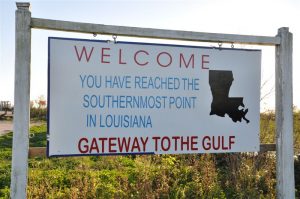
by admin | Jun 18, 2013 | Featured Posts, Greater New Orleans
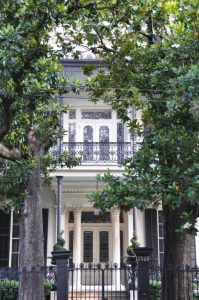 |
| Another Garden District Beauty |
In the midst of t-ball and swim lessons, we’ve been sticking close to home as of late, taking short adventures in and around New Orleans. Our latest outing was something we rarely do, a guided walking tour of one of the most extravagant sections of the city – the Garden District. Once home to wealthy Americans looking to settle outside of the French Quarter, today many of the area’s mansions boast historic signs detailing fascinating stories that often end with links to Hollywood stars.
We met our guide, Kevin from NOLA Native Tours, on Magazine Street at the Defend New Orleans store. The early morning weather was clear with a cool breeze that made the shaded sidewalks comfortable on this mid-summer day. Kevin led us north on 1st Street, deep into the heart of the quiet neighborhood. Aside from the occasional dog-walker, we had the street to ourselves, with no one watching us gawk at the beautiful homes before us.
In the early 1800s, this area was known as the city of Lafayette, eventually annexed by the city of New Orleans in 1852. Our tour guide pointed out notable architecture styles, from Victorian to Italianate and Greek Revival, all with varying degrees of cast iron railings and flickering Bevelo gas lanterns. I was particularly fascinated by the large marble slab lying by the curb in front of one of the homes. I never would have guessed it was once used as a step for ladies exiting carriages, a fact that so easily painted an imaginary scene of well-dressed revelers arriving in their carriage for an evening party.
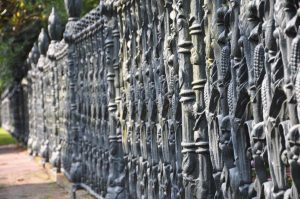 |
| Cornstalk Fence |
We passed the home where Jefferson Davis, the first and only president of the Confederacy, died. Nearby, vampire-author Anne Rice grew up in the Brevard-Rice house, just a few steps away from the Mannings’ mansion (yes, that would be the Mannings…football icons Archie, Peyton and Eli). On Prytania, the French flag waved in front of the French Consulate, while across the street, a rectory once built for Redemptorist priests later became another possession of Anne Rice and then actor Nicholas Cage. Meanwhile, an intricate cornstalk fence surrounded one grand home, proving that the famous fence does exist outside of the French Quarter.
The tour paused at the Rink, a collection of boutique stores, the Garden District Book Shop and a coffee shop, before unleashing us inside Lafayette Cemetery Number 1. We spent nearly half an hour here, photographing the elaborate above-ground tombs with springy plants emerging from their crevices. This city of dead is crowded and slightly crumbling, details that somehow make it even more alluring.
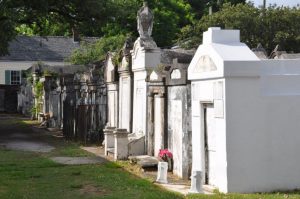 |
| Lafayette Cemetery |
The last stretch of our journey showcased one of the city’s best-known restaurants – Commander’s Palace, and exquisite homes perhaps more famous for their architecture than for their Hollywood owners (Sandra Bullock and John Goodman). It was a pleasant walk in the hands of a knowledgeable tour guide, one who casually turned a morning stroll into an exploration of beauty, time and entertainment.
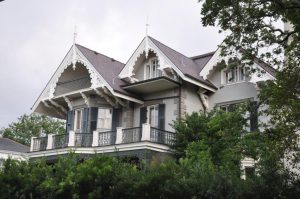 |
| Sandra Bullock’s Garden District Home |

by admin | Jun 4, 2013 | Greater New Orleans
On a coveted three day holiday weekend, t-ball and birthday parties kept us tied to the city, so we used the extra day to explore our hometown. It’s so easy to settle into work and school routines during the week, and take off exploring the unique small towns and parishes on our days off. Yet, I also find that we often forget how interesting our own city of New Orleans is, so we donned our tourist hats and headed to the French Quarter.
Being a local has a few perks, such as knowing to park at the foot of Canal Street at the Shops at Canal Place. We spent five minutes buying the kids a muffin at Starbucks, and then immediately took our parking ticket to the Concierge to be validated (a nice savings in parking fees). Another perk was catching half-price tickets to the paddlewheeler Creole Queen on Travelzoo – all the motivation we needed to try out the river cruise.
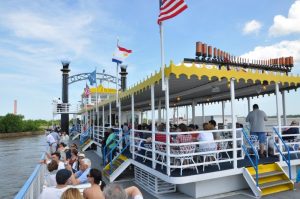 |
| Aboard the Creole Queen |
We walked the short distance to the boat’s dock and secured our tickets for the daily excursion. The line to board was already wrapped around the side of the Riverwalk, and with one glance at the kids, we knew they were not going to wait. So we instead strolled along the river, watching the massive ships go to and from the busiest port complex in the world. We returned as the last of the passengers took their group photo and passed through security. The downside of waiting to the end was no more available seats on the ship’s deck, but seeing as our two- and five-year-old rarely sit for long, it wasn’t that big of a deal.
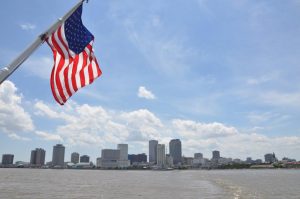 |
| View of the city from the Creole Queen |
We watched as they unwound the ropes holding the boat to the dock and started up the paddlewheel, slowly propelling us out into the middle of the river. Inside people were lining up for hot food and cold drinks, while we toured the boat, investigating the view from every floor and side. A narrator pointed out memorable locations, and the kids discovered hiding places under overhanging decks and built-in “slides” next to indoor stairways. We relished in the breeze counteracting the hot sun, and hid in the shadows when we needed a break. Before long, we passed the Bywater, the Industrial Canal and the Louisiana National Guard’s headquarters at Jackson Barracks on our way south to Chalmette Battlefield in St. Bernard Parish.
As many times as we’ve walked the grounds and toured the home at this National Historical Park, we
 |
| Musket firing demonstrations at Chalmette Battlefield |
had never arrived via the river and never visited on a day when costumed living historians had set up camp on the property. We learned how young ladies looked “graceful” while playing games, explored a tent and common items carried by 1815 soldiers and watched musket firing demonstrations that had our youngest shouting “No!” at the volunteers. Meanwhile, our oldest, Charles, was anxiously listening for the one long and two short whistles that would signal our five minutes to reboard. As soon as they blew, he took off running toward the boat, warning us he would leave us behind if we didn’t make it back in time.
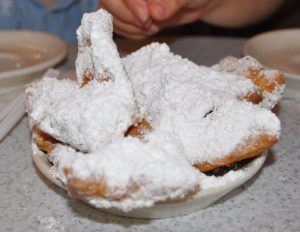 |
| Cafe du Monde beignets |
The kids were tired when we finally arrived back at port, so we popped them in the strollers and let them relax as we walked along the river down into the heart of the Quarter to Cafe du Monde. Once again, the line for outdoor seating was stretched far out beyond the famous cafe, but we strolled right past them and entered the air conditioned indoor area and grabbed one of several empty tables. Here, we re-energized with cafe au lait, and the kids perked up with a great deal of powdered sugar on top of their beignets. You could sense the sugar settling into their system, sending jolts of energy through every inch of their tiny bodies.
 |
| Andrew Jackson in Jackson Square |
Rearing to go, we crossed the street to Jackson Square, greeting the mules lined up waiting to lead
buggy tours. While August “neighed” at them, Charles spotted a balloon man and scored them both balloon swords, which came in quite handy for the sword fight that ensued around the statue of Andrew Jackson. The Quarter was alive with music and street performers, brass bands and cheering crowds. A wedding party paused to snap photos outside St. Louis Cathedral before the bride took a deep breath and entered the church doors. We took it all in for a while, venturing around back of the Cathedral to investigate the artists there and savoring the vibrancy for which New Orleans is known.
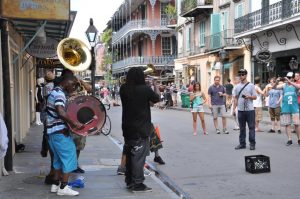 |
| Musicians on Royal Street |
When the musicians paused, we took our cue and headed up Chartres to the Napoleon House for a dinner of shrimp remoulade and red beans and rice for the kids. Paul and I topped it off with a Pimms Cup, a light, summer drink, and reminisced about our own wedding reception held upstairs here more than 10 years ago. Built in 1797, the house was offered in 1821 as an escape to exiled Napoleon. Although the French leader never made it to Louisiana, the restaurant and bar today pay homage to him through paintings, statues and various decorations all depicting Napoleon and his life.
 |
| Napoleon House |
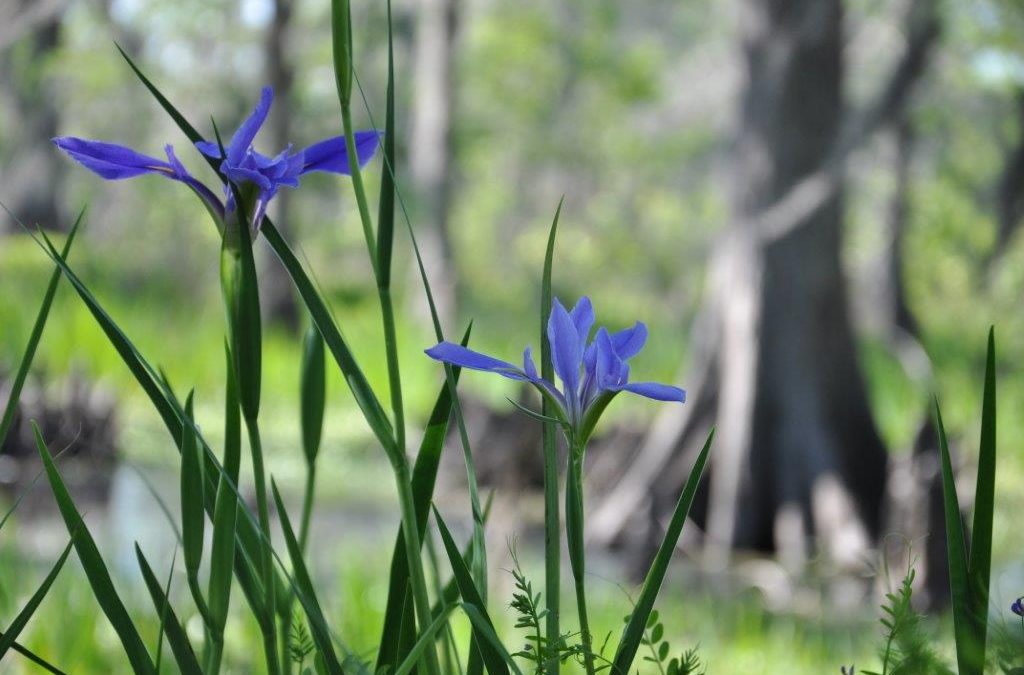
by admin | Apr 9, 2013 | Greater New Orleans, Most popular
We’ve been on a kick lately traveling to the end of all the roads in Louisiana–first in Plaquemines, then St. Bernard and now Jefferson via the Town of Jean Lafitte. It’s altogether quite a different drive than the other two, most notably because we didn’t seem to pass any refineries along the way–or at least any we could see.
 |
| Hope Haven |
The adventure began when we exited the Westbank Expressway in Marrero and turned on to Barataria Boulevard. Almost immediately, we were met with some of the most striking architecture in Jefferson Parish. Built in the 1920s and 30s, Hope Haven’s Spanish Colonial Revival-style buildings stand out amid this otherwise typical suburban area. From my Internet searches, it appears the impressive buildings house a school and a case management and family support center run by Catholic Charities, but they are grand enough to rival the Spanish missions found in Texas and California.
 |
| The water-filled, historic Town of Jean Lafitte |
Continuing south, we made a left on Leo Kerner Parkway and entered a long stretch of uninhabited highway. Both this route and Barataria Blvd. lead to Jean Lafitte National Historical Park and Preserve, one of our favorite spots to explore the swamps and a place I’ve written a lot about in the past. This weekend, however, we had a new destination, passing by the park’s entrance and ascending the high bridge over the Intracoastal Waterway. As the road descends, a pirate ship rocking on the high seas announces you’ve entered the historic town of Jean Lafitte.
We followed scenic Jean Lafitte Boulevard along Bayou Barataria, noting that the majority of the elevated houses here seem to be permanent homes to the town’s residents rather than secondary fishing camps. Our first stop was the new Lafitte’s Barataria Museum and Wetland Trace, which celebrated its grand opening on Saturday. A large tent out front indicated the celebration, and the kids were shouting “balloons!” before we left the car. While they ransacked the kids’ table, gathering up stickers, coloring books, pirate bandanas and tattoos, Paul and I eyed the free tastings of alligator-stuffed mushrooms and crab cakes. In hopes of relaxing and enjoying the live Cajun music, we set up our folding chairs in front of Bruce Daigrepont and his band, yet the kids had sat long enough in the car and were not remotely interested in relaxation.
.jpg) |
| Lafitte’s Barataria Museum |
So we herded them into the museum, where a half hour movie introduced us to the town’s history and that of its residents. Beautiful aerial shots showed the village surrounded by its lifeblood of water, swamp and marsh, and one resident drove the message home by saying he never knew there was solid land until he was taken to the French Quarter when he was 14. The town itself takes its name from the notorious pirate Jean Lafitte, who used the mysterious swamps to hide his smuggling operations. Today’s residents aren’t quite as scandalous, yet those we met were perhaps just as entertaining and lively.
The museum, although small, is packed with intriguing items from the area, from an entire display of the animals found here to a gun used by one of Lafitte’s pirates during the Battle of New Orleans. Although 2-year-old August buried his face when confronted with the talking alligator, the other children present got a kick out the reptile. Unfortunately, two among us didn’t have the patience for the oral history presentations, so we skipped that section to instead head out back to the Wetland Trace.
 |
| Alligator along the Wetland Trace |
Nearly a mile long, this boardwalk trail through the swamp caught our 5-year-old’s attention like nothing else that day. We spent an hour and half stalking snakes and lizards, pointing out alligators to others passing by and trying to determine what and where all that clicking noise was (our best guesses were baby birds in the rookery or click beetles taunting us from the trees). Although the lines were too long for us to join the swamp tour leaving the docks off the back of the boardwalk, the entire mission was still a success as we saw five snakes of varying sizes and colors, countless water turtles and one very close alligator. Plus, now we have something more to go back for next time.
 |
| Boat ready for a new paint job |
Back in the car, Charles begged to continue down the road as he wasn’t ready to go home yet, so we kept driving to see what else we could find. On our way to the museum, we had passed an old plantation, still standing but fighting a losing battle with the elements and weeds threatening to suck it back into the earth. Now, on our left, an old boat was lifted on barrels, preparing for an overhaul from its owner.
At the museum, we had learned that Lafitte is home to 11 cemeteries. Fleming Cemetery, notable for its white-washed tombs on top of an Indian mound, is privately owned and inaccessible to the public, yet can be seen from the water and is a highlight of area boat tours. Another, Lafitte Cemetery, is said to be the burial grounds of Pirate Jean Lafitte himself. This was our last photo op before the main road branched off into smaller outlets and essentially ended at a busy boat ramp bustling with fishermen.
 |
| Legend says this is the burial grounds of Pirate Jean Lafitte |
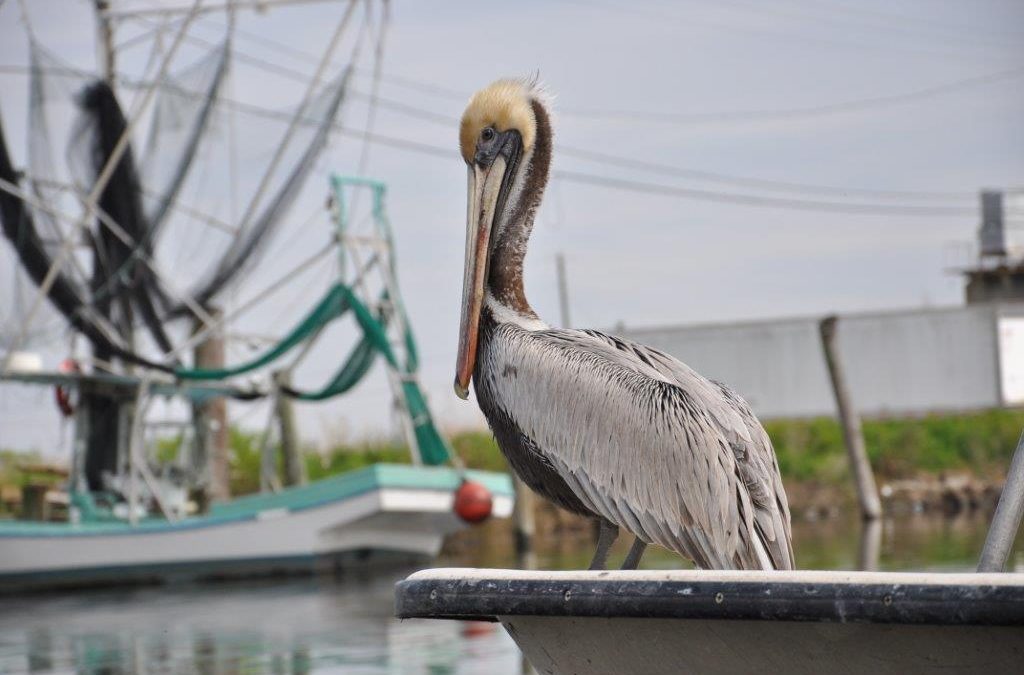
by admin | Mar 19, 2013 | Greater New Orleans
Nearly two years ago, we drove the San Bernardo Scenic Byway through St. Bernard Parish, headed for the Chalmette Battlefield and the Los Islenos Fiesta. This weekend we returned to hit a few spots we had missed on our initial journey, starting with Old Arabi and finishing in Shell Beach where another Louisiana roadway abruptly ends at a large body of water.
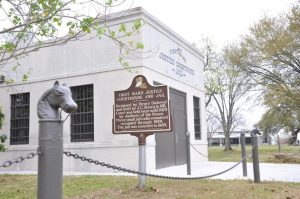 |
| Old courthouse and jail in Arabi |
As soon as you cross into St. Bernard Parish, you reach the Old Arabi Historic District. A quick drive up and down the roads leads past a number of historic sites, such as the “Andy Griffith-style” jail built in 1911. The beautifully designed Maumus Center, St. Bernard’s first high school that later served as a community center, was gutted and undergoing a massive overhaul that would undoubtedly return this building to its previous splendor.
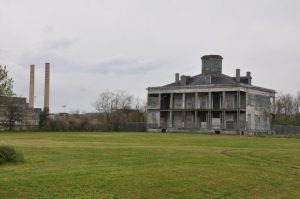 |
| LeBeau Plantation |
One of the most fascinating landmarks in Old Arabi is LeBeau Plantation, an 1854 mansion boarded up and presiding over a large open field. The very sight of it conjures up ideas of ghost stories and tales untold. Down the street, however, the Greek Revival Cavaroc House appears in pristine condition at the end of a row of majestic palm trees. The two homes can’t be more different, though. While one stands in near ruin yet proudly displayed for photographs, the other is a bright gem next to the industrialized Domino Sugar Refinery yet tightly guarded against any would-be sightseers. In fact, try to take a picture of this mansion, and you’ll be tracked down, instructed to delete all your photos and have your license plate number recorded. I’m talking hyper-security.
So we carried on, following the scenic byway past the Chalmette National Historic Park and National Cemetery and under a lane of live oaks known as the Dockville Oaks. When the main road split and headed east, we turned right and continued alongside the Mississippi River to St. Bernard State Park. Letting the kids run out some energy, we started with a short nature trail linking the picnic area to the swimming pool, a top attraction during the hot summer months. Luckily, they were in the mood to run because one pause and the mosquitoes attacked. We escaped quickly and found safety in the open picnic area, where we ate our PB&J sandwiches next to a very curious lizard. Halfway through the gourmet meal, the kids spotted the playground and went off to climb, jump and make sand castles–in between sneaking around poles to “spy” on the girls celebrating a birthday party.
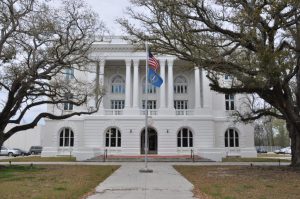 |
| The Old Courthouse near the Los Islenos Fiesta |
It was a nice break before climbing back in the car and backtracking our way to the byway again. We soon approached the Old Courthouse, an impressive building for any city, but even more so being located in the largely rural section of the parish. Just past the courthouse, a long line of people and the flickering lights of carnival rides alerted us that we had once again visited during the Los Islenos Fiesta. We were tempted to stop but chose to continue on to our destination of Shell Beach, the tiny fishing community we had not reached previously because the road was closed. Alas, a few minutes later and we discovered that the road was still closed two years later. This time, however, we were not so easily thwarted, and instead turned the car around and returned west until we found a crossover to Highway 46, a parallel route to the byway.
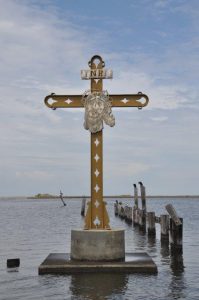 |
| Katrina Memorial |
The highway bypassed the small towns and provided a quicker route to Florissant Highway, the far-reaching road to Shell Beach and Hopedale. Ruins of homes, vehicles and bare, dead trees stood as hurricane casualties, leaving the eerie impression that we were approaching nothing more than an abandoned village. And then the scenery changed and a waterway stacked with colorful boats led to a thriving, vibrant community. Pelicans guided the last few miles of our drive until we parked in front a memorial dedicated to those who died during Hurricane Katrina. A large cross bearing the face of Jesus was rooted in the waters before us, and a plaque listed the names of the St. Bernard residents who passed.
Climbing out of the car, I mistakenly thought ash was falling from the sky around me. It only took a moment to realize it was a flurry of biting gnats. A family, with every inch of their bodies covered with clothing, was fishing and crabbing here, and the birds sat patiently awaiting their next catch. In the distance, the remains of a large fort was oddly out of place floating above a sea of marsh grass. While I swatted the bugs, the kids seemed oblivious, instead chasing birds and collecting oyster shells before we gave up and retreated to the car.
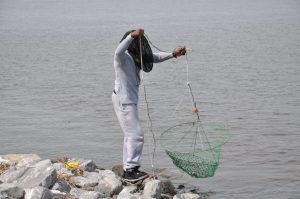 |
| Crabber protected from the gnats |
Our final stop was Sebastopol Plantation, a place we had fond memories of from our previous visit. We passed through the gate thinking we would soon see owner Alberta Lewis, who would gladly let the boys marvel at the chicken coop. Instead, we found her son, who broke the news that his mother had passed away. However, he was just as eager to let us roam the property. Since our last visit, and before Alberta had died, she had acquired a set of turkeys to add to her collection of chickens, roosters and peacocks. Much larger than I expected, the male turkey strutted and shimmied all around us, preparing for a showdown with our four-year-old, who was only slightly taller than the bird. It was the perfect ending to our day’s adventures and left us with much to talk about later.
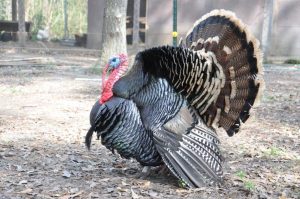 |
| Sebastopol’s turkey |
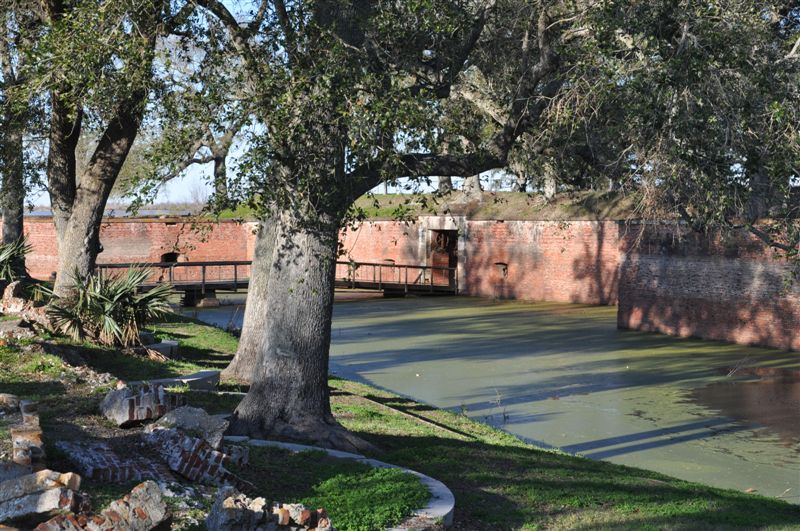
by admin | Feb 19, 2013 | Greater New Orleans
It’s not easy to get lost in Plaquemines Parish. There’s one main road that runs down the left side of the Mississippi River and one down the right. Once you get on it, you simply drive straight ahead until you reach the end. We chose Highway 23 on the left side and spent the day exploring our rural neighbor.
 |
| Looking for bugs in the Woodlands Conservancy |
It was late morning before we headed out, jumping on the Crescent City Connection to cross the Mississippi and then exiting nearly immediately at General De Gaulle Dr. The road leads away from the city and high onto a bridge over the Intracoastal Canal, curving back down to drop us in the middle of pasture land. Just a short jaunt from here is Woodlands Conservancy, home to 13 miles of hiking and equestrian trails winding through forests and canals.
Although the 6-mile Bottomland Trail was intriguing with its promise of 10 World War II Ammunition Magazines, we glanced at our 2 and 4-year-old kids and chose the easier 1.1-mile Upland Trail for our own sanity. The recently wet trail, which began by snaking out alongside a canal, was now hardened mud perfectly capturing the footprints of the deer that walked the path before us. Charles, dressed in his entomologist outfit, examined the footprints with his magnifying glass in between chasing the crickets and large mosquitos in hopes of capturing one for his bug catcher.
 |
| Becnel’s Farmers Market |
Soon, the trail veered away from the water and entered the forest, where thousands of yellow flowers blanketed the ground. Being little gentlemen, they picked flowers for their mommy while dad photographed them foraging in a mass of yellow. Every so often, the trail passed a large swamp maple dropping dark red leaves to the ground or a giant cypress standing watch over the smaller trees surrounding it. It was a pleasant, leisurely walk through nature that looped back to the beginning and ended near a pavilion perfect for a post-hike snack.
The food only made our stomachs grumble more, so back in the car and now on Highway 23, we made our next stop Becnel’s Farmers Market. Here, we re-energized on tamales, boudin and alligator sausage, while the kids enjoyed hot dogs from the small food vendor next door. Before continuing on, we browsed the many citrus trees for sale and admired the Blue Angel plane elevated in the air across the street at the Naval Air Station.
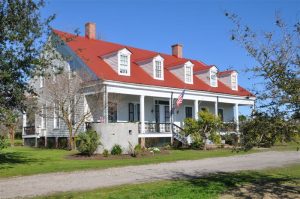 |
| Woodland Plantation |
As we drove south, the land around us thinned, leaving an uneasy feeling of vulnerability. Modest homes intermingled with sprawling refineries in this landscape dominated by fishing and oil. In the midst of this rural community lies the lovely, red-roofed Woodland Plantation, famous for its image gracing the label of Southern Comfort bottles since 1934. We parked by the main house and knocked on the front door, which swung open at our touch. Now a bed and breakfast, the plantation is open for browsing and viewing by anyone who chances by, and we explored each of the cozy rooms filled with antique furniture.
Next door, the old St. Patrick’s Church was moved to this location and now served as Spirits Hall, where six-course dinners are served up to anyone making reservations. The hostess told us how most of the guests were fishermen who stayed overnight before going out on one of the fishing charters arranged by the plantation staff. At the end of the day, the chef cleans and cooks their catch and serves it up in a delicious meal.
The property, including the plantation, received nine feet of water from last year’s Hurricane Isaac, yet you never would have known it. In addition to the main house and church turned dining hall, the beautifully landscaped acreage contained a newly renovated overseer’s house, an old slave cabin currently under repair and the ruins of the sugarcane mill. We strolled the property, at ease to make ourselves at home, while the kids giggled and squealed at the affectionate attention of the home’s cats.
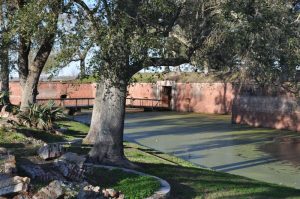 |
| Fort Jackson |
We had a difficult time persuading them to leave the cats behind so we could continue down the road to Fort Jackson. Built between 1822 and 1832, the fort played a role in the Civil War and stands in a prominent spot overlooking the Mississippi River. Information is hard to come by online regarding the fort’s status, and although last year’s 150th Civil War Anniversary website states that the sight is open daily, we found the gates locked and signs posted saying no public entrance.
We made the most of our time there, though, and walked around the outer wall of the fort, which at times afforded glimpses into the fort’s interior. A monument on the bank of the river denoted the spot where the first Mardi Gras took place in 1699 and another showed a picture of the explorer LaSalle underneath a cross soaring up into the sky. As we walked, something–“perhaps the loch ness monster,” Charles informed us–seemed to follow us in the moat below, leaping into the air every so often to show its large black head.
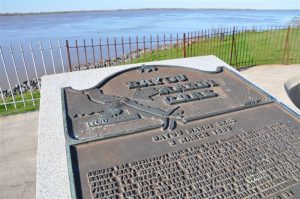 |
| Plaque denoting Bayou Mardi Gras with MS River in background |
As the sun lowered, the air chilled and we hurried to reach our final destination – the end of the road. It wasn’t hard to find the flat Tidewater Road only inches higher than the water lapping at its sides. Cypress trees graced both sides of the road, and countless birds perched in their ghostly limbs, making this a prime spot for birding enthusiasts. We even spotted a flash of hot pink and jumped at finding the elusive roseate spoonbill standing silently in the water.
At the end, the road simply disappeared and a sign welcomed us to the “southernmost point in Louisiana,” where another refinery reminded us of the big business dominating Louisiana’s coast. Yet, as unnatural as it looked in that cypress swamp, its presence didn’t deter the thousands of birds sitting along every pipe and building there.
It was dark as we drove back to the city along the same road and encountered a mass of lights floating above the houses to our right. We were shocked to realize it was a cruise ship making its way south along the Mississippi, a city in itself, seemingly hovering in the air beyond the hard-working residents of this parish.
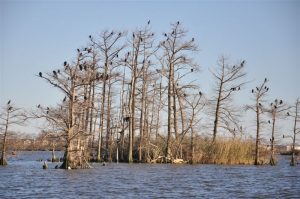 |
| Two worlds at the end of the road: cypress trees… |
 |
| And a refinery – both covered in birds |
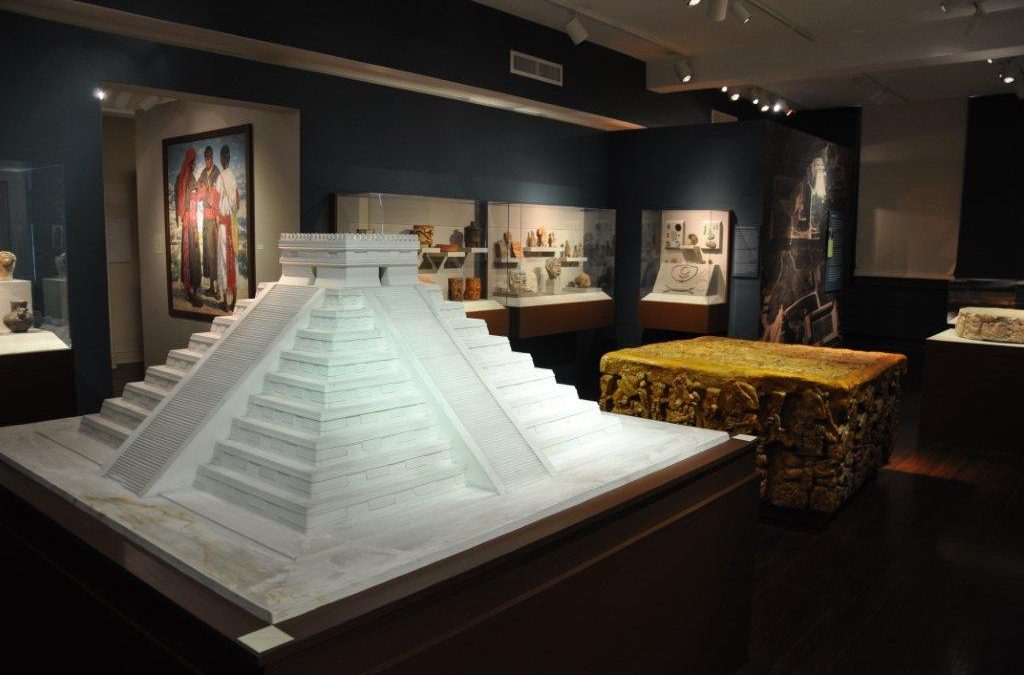
by admin | Jan 29, 2013 | Greater New Orleans
On our evening walks around Uptown New Orleans, we’ve discovered one the best places to take rambunctious kids is Tulane University. We get a little bit of exercise walking there, and they get to jump out as soon as we reach the university and let loose. It’s the perfect place to hunt for cicadas and stick bugs, climb in the rock garden, play in the fountains and chase the stray cats that seem to thrive on campus.
 |
| Carved Stone Head |
As part of our routine, we stop in the Anthropology building for a water and bathroom break and to peak in the main office at the fascinating decorated skeleton occupying the corner chair. During the recent hype over the end of the Maya calendar, a Times-Picayune article came out about a Maya exhibit in this very building we so often frequented. “Faces of the Maya: Profiles in Continuity and Resilience” was hidden two floors above us in Dinwiddie Hall’s Middle American Research Institute.
Normally only open Tuesday through Friday, 10 a.m. to 3 p.m., the museum was fairly inaccessible to us. However, on our latest walk across campus, we decided to ascend the steps to the third floor to maybe catch a glimpse of the exhibit through the window. Luckily, the Institute Director Marcello Canuto must have heard all the ruckus we were making outside his office, and upon discovering what we were up to, gladly opened the museum for us.
It was quite an amazing display depicting the Maya culture, from carved figurines and pottery examples to delicate jewelry and ballgame rubbings. The story of the Maya is intertwined with the artifacts, leading the viewer through the civilization’s earliest existence to today’s descendants who still live throughout southern Mexico, Guatemala, Belize and Honduras.
 |
| Plaster Cast from Palenque God House |
The kids were drawn to a plaster model of El Castillo, a scaled-down version of a Maya temple-pyramid with a series of steps perfectly sized for the butterfly that we had picked up on today’s outing. An accompanying description explained that when the sun hits the platform during the equinox, snakes appear to slither down the pyramid–a sight I can only imagine to be awe-inspiring.
Nearby, I was drawn to a plaster cast of an altar so intricately detailed I could have spent hours staring at it. Alas, as I looked up, the kids were already out the door and headed down the stairs. I briefly stopped one last time to admire a vibrant painting of three Maya men seemingly deep in discussion before darting out the door and shouting a quick “thanks” to Director Canuto.
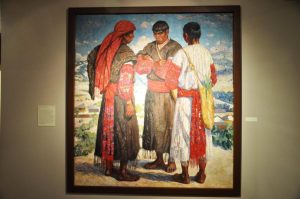 |
| Painting of the Maya |





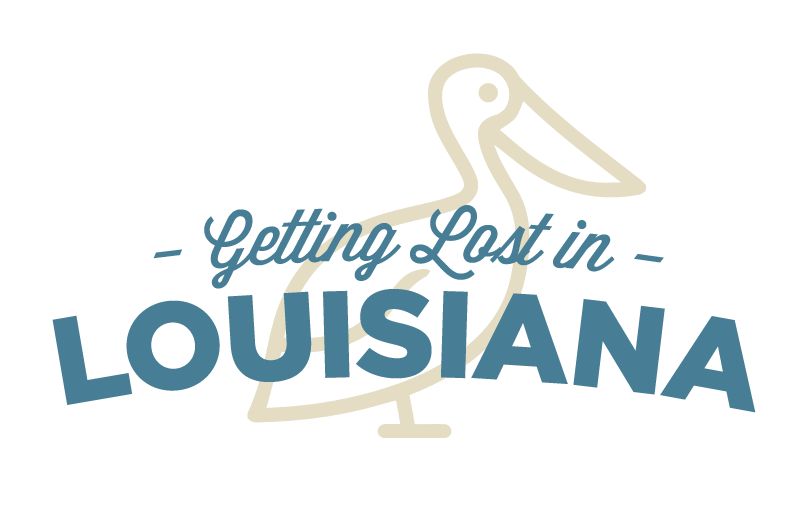









.jpg)








